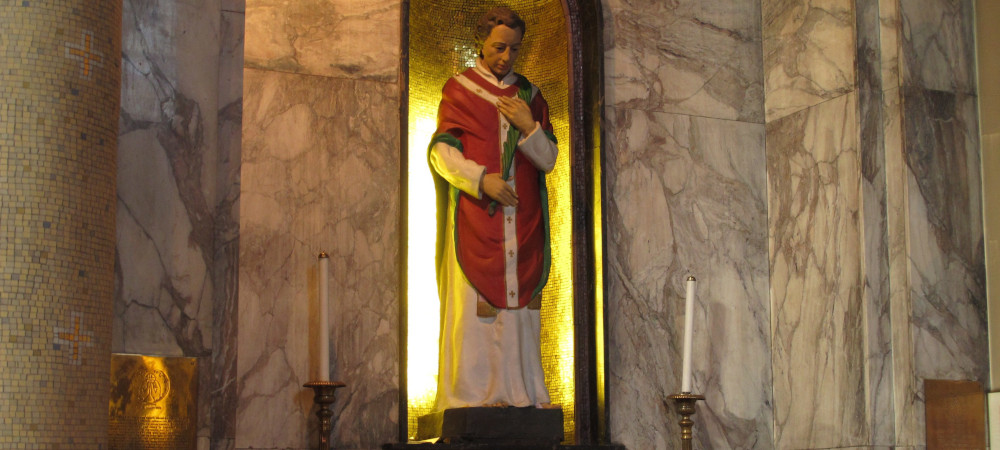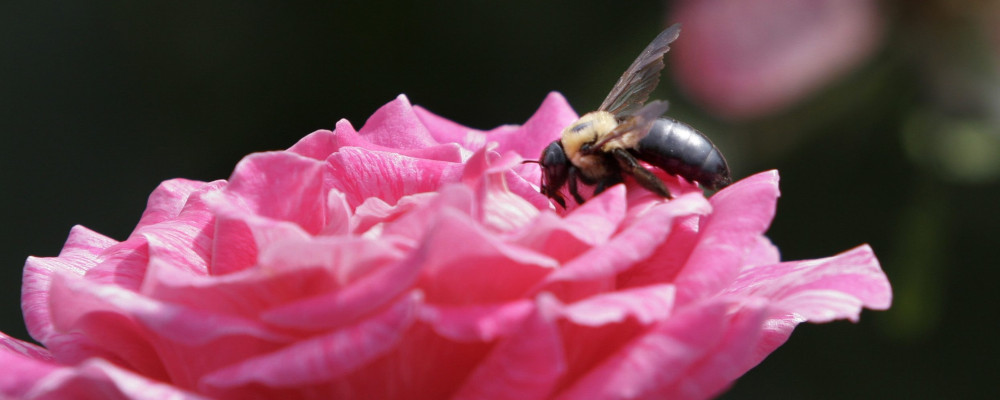Saintly patronage can be a funny thing. By a series of medieval confusions, St. Balthasar became the patron saint of card players, and now by extension blackjack dealers. And St. Drogo somehow ended up as patron of both coffee shops and unattractive people, a coincidence becomes somewhat clearer every time I am forced into a Starbucks looking for a free bathroom. St. Valentine’s portfolio of patronages is impressively eclectic, including plague victims, epileptics, the mentally ill, fainting, happy marriages, romantic love, beekeepers, and the island of Lesbos, where most of his relics are kept. Some lists also include greeting cards, but that sounds like a Hallmark conspiracy to me.
The connection between love and bees—between fertility and fertilisation—is, at first glance, straightforward, but that doesn’t appear to be the relevant link in this case. No one seems to know why the saint is the patron of either lovers or bees, let alone the two together. For all we know, the patronages may refer to different Valentines, as at least two and possibly three saints of that name crop up in the late Roman period. The Church eventually settled on a single feast day, and thus presumably a single saint, in the late fifth century.
The modern phrase—“the birds and the bees”—refers to something rather more basic than romance, but bees and love, at least, have a long association. There is a tantalising reference in Pindar to Aphrodite and “holy bees,” but then bees are associated with many antique deities, and perhaps with the Greek idea of divinity itself. Then there is Idyll 19, attributed to Theocritus, in which Cupid steals a honeycomb from a hive and complains to Aphrodite of the sting he gets for his troubles. His mother is not impressed, an attitude Lucas Cranach captured well in his many paintings of the scene: “‘What?’ cries she, ‘art not a match for a bee, and thou so little and yet able to make wounds so great?” In other words, Cupid, whose arrows cause lovers much greater pain than a bee sting got no less than he deserved.
The connection persists in modern writers. Tolstoy, who had a special fondness for bees, is often misquoted on social media as saying: “One can no more approach people without love than one can approach bees without care.” The more accurate quote from Tolstoy’s “Calendar of Wisdom” entry for April 21 is: “In the same way as you cannot work with bees without being cautious, you cannot work with people without being mindful of their humanity.” It is clear we are dealing here with a more general form of love, something closer to Kant’s “Formula of Humanity,” which requires that we treat people always “as an end, never merely as a means.”
Tolstoy’s most famous bee references are in War and Peace, where, in what is surely one of the most extended and convoluted metaphors in literature, he compares a barren Moscow under Napoleon to a queen-less hive. The analogy is so detailed that it reads like a page from a scientific journal has been accidentally inserted into the manuscript during printing. Later, Tolstoy uses multiple ways of looking at a bee (that of a stung child, a poet, a botanist, &c) to show the impossibility of reducing characters or nations to a single purpose discoverable from one perspective.
In Anna Karenina, Tolstoy again shows off his naturalistic appreciation of bees.
The old grass and the emerging needles of young grass turned green, buds swelled on the guelder-rose, the currant bushes and on sticky, resinous birch trees, and bees on their first spring flight from their new home started buzzing about the gold-flecked willows.
Rosamund Bartlett has written a delightful and erudite article on the difficulty of translating this and similar passages (which she did for her fluid 2014 translation). In it, she analyses other translations of the technical terms that Tolstoy uses, which can only come from the direct experience of bees Tolstoy had during his “typically obsessive but short-lived passion for beekeeping in the 1860s,” and explains her choices.
Rather more pedantically and less poetically, in 1714 the Dutch émigré Bernard Mandeville published a doggerel poem, The Fable of the Bees, in which he attributed a society’s prosperity to the sum of its citizens’ private vices. A sort of amoral proto-Adam Smith, Mandeville describes the division of labour, the invisible hand, and the paradox of thrift 60 years before the Wealth of Nations. (Warming to his theme, he later published a Modest Defence of Publick Stews [brothels], which St. Valentine definitely would not have approved.)

Turning from the bees to the birds, and more appropriate to the modern celebration, is another fable: Chaucer’s A Parlement of Foules1The poem’s name almost certainly gives us, via linguistic rebracketing, the collective noun ‘a parliament of owls’. Not an original term of venery (owls don’t normally congregate), it first appears in the 19th century and was popularised by CS Lewis in The Silver Chair. [Fowls], in which many of the customs of modern St. Valentine’s Day first appear. In fact, the Renaissance scholar Jack Oruch has argued that Chaucer was the first writer to connect St. Valentine with romance. Oruch believes that Chaucer was inspired by the coincidence of the saint’s day with the coming of spring, when animals begin to pair for mating (or, like the liberated lady eagle in the poem, choose to remain single).
Bees make only one appearance in Chaucer’s poem, and it is not a happy one (for them). Listing the various birds assembled to await romantic partnering, he mentions “the swallow” whom he describes as “mordrer of the flyes smale / That maken hony of floures fresshe of hewe” (murderer of the bees / that make honey of flowers fresh of hue). But that thin allusion is enough for me to justify giving the last hopeful word on St. Valentine’s Day to Chaucer:
Saint Valentine, who art full high aloft –
Thus sing the small fowls for your sake –
Now welcome summer, with your sun soft,
That this winter’s weather does off-shake.





